Plan checklist
Kavanagh 2018
1 Gunns Farm , Lac McGlashan
Planting plan created by Water Rangers
Funded by • Fisheries Canada •

Schedule A:
Plants & Property
Land Characteristics
This planting plan is designed based on the land characteristics identified during the day of the site visit. Plants are chosen according to the soil and light conditions on your property. The number of plants chosen for each planting compartment takes into account the square metre area of the space, as well as the amount of current vegetation cover. Your property is part of ecoZone: 4b
Land Characteristics by Compartment
| Length | Width | Area | pH | Soil | Moisture | Light | Height | |
|---|---|---|---|---|---|---|---|---|
| A | 10m | 8m | 40.5m2 | acidic, basic | loamy, clay | normal, moist | full sun, partial sun | max 1.5m, max 2m, max 3m |
| B | 7m | 8m | 56m2 | acidic | sandy, loamy | dry | full sun, partial sun | max 1.5m, max 2m |
| 17m | 8m | 96.5m2 |
Plant Selection Summary
The following shrubs and trees are chosen for their suitability and survivability given the current soil and light conditions in each compartment on your property, as well as preferable features.
| Plant Species | A | B | Potted | Bareroot | Wildflower |
|---|---|---|---|---|---|
| Small Cranberry | 2 | 2 | |||
| Fireweed | 5 | 7 | 4 | 8 | |
| Smooth Blackberry | 6 | 6 | |||
| Fly Honeysuckle | 4 | 4 | |||
| Oswego Tea (Red Bergamot) | 2 | 2 | |||
| Canada Anemone | 5 | 5 | |||
| White Turtlehead | 6 | 6 | |||
| Subtotal | 19 | 18 | 6 | 29 | 2 |
| Totals | 37 | ||||
Plant Information
The following table summarizes key information about each plant selected for your property.
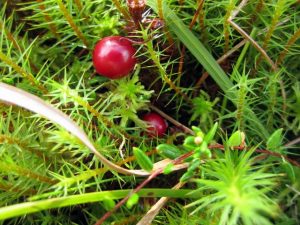
|
Small CranberryHeight: 10 cm
The Small Cranberry is a evergreen, perennial shrub that only grows about 10 cm in height. This plant may also be known by the common names Bog Cranberry or Swamp Cranberry. While considered a shrub, the Small Cranberry grows vine-like branches that trail and root along the ground. The leaves are small, simple, leathery, lance shaped, shiny dark green, alternately arranged, and have rolled edges. The flowers are small, showy, reddish pink colored, nodding, have four petals, have a cluster of long dark red stamens, appear on erect stems, and bloom between June and July. These flowers transform into dark red cranberries that reach maturity between August and September then last throughout the winter. The fruit is beneficial to wildlife species, like birds and small mammals. This species is an early colonizer, often being one of the first shrubs to grow following wild fires.
|
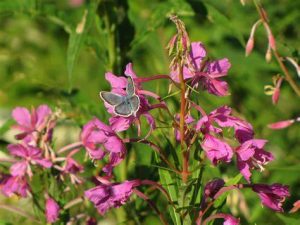
|
FireweedHeight: 1.5 m
Fireweed is a perennial wildflower species that grow up to 1.5 m in height. The stem is smooth, round, and turns from green to red towards the top of the plant. The leaves are light green coloured, alternately arranged, narrow and lance shaped, similar to Willow leaves, have a prominent central vein, and have entire margins. The flowers are showy, purple to pink coloured, have four petals and four sepals, appear at the top of the stem, and bloom between June and September. The flowers are replaced with seedpods that split into multiple sections, beginning at their tips and curling backward, releasing tiny seeds with small tufts of white hair. The flowers are beneficial to pollinator species, like bees and butterflies. This wildflower spreads well and can be used to naturalize un-vegetated areas. The roots can be useful for controlling erosion and stabilizing shorelines. Fireweed gets its name due to its ability to quickly colonize areas recently burned by fire.
|
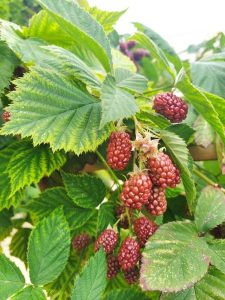
|
Smooth BlackberryHeight: 2m
The Smooth Blackberry, also referred to as Canadian Blackberry, Thornless Blackberry and Smooth Highbush Blackberry, is a medium sized shrub species and member of the Rose family, that reaches heights of 2m. This species forms irregular thickets with reddish-purple to brown stems. Leaves produced are lance-shaped, arranged alternately along the branches and are compounded with five leaflets. During the fall, the leaves turn from light green to dark red or deep purple. During the spring and summer, five-petaled, white flowers grow in clusters of up to 25 at the end of the branches. By mid-summer, the flowers give rise to edible purplish-black fleshy fruits, which ripen by late August. The fruiting bodies of this shrub provide an important abundant food source for many birds and mammal species. This shrub is good for controlling erosion and stabilizing shorelines.
|
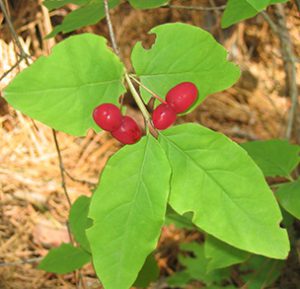
|
Fly HoneysuckleHeight: 1-2m
The Fly Honeysuckle is a medium-sized deciduous shrub that typically grows between 1-2m, and is naturally found throughout Ontario, Quebec, and Eastern Canada. This perennial shrub is multi-stemmed with thin, woody branches and can be grown so that it resembles a vine species. The Fly Honeysuckle's leaves are light green, simple, and oppositely arranged. Leaves are oval in shape and hairless, except at the margins where fine hairs are visible. This species produces flowers which are bell-shaped, white to yellow in colour, drooping in pairs of two, and bloom during late spring. Flowers give rise to large red-orange berries during late summer, which are a favorite to many songbird species.
|
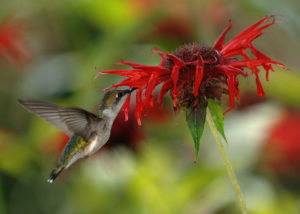
|
Oswego Tea (Red Bergamot)Height: 50 cm
Oswego Tea is a showy perennial wildflower species that typically grows about 50 cm in height. This plant may also be known by the common names Red Bergamot or Scarlet Beebalm. The leaves are dark green, oval shaped, have a minty fragrance. The unique flowers are bright red and grow in dense rounded clusters, with individual tubular flowers that bloom between May and October. The beautiful flowers of Oswego Tea attract various pollinator species like hummingbirds, butterflies, and bees. The Oswego Tea plant is susceptible to a common fungal disease, called powdery mildew, when planted in dry soils. Historically, the leaves of the plant have been used for antiseptic purposes, as well as poultices to heal minor wounds and skin infections.
|
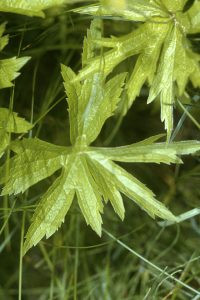
|
Canada AnemoneHeight: 50 cm
Canada Anemone is a perennial wildflower species that typically grows about 50 cm tall. This plant may also be known by the common names Meadow Anemone or Roundleaf Anemone. The leaves are basal, dark green, deeply divided into 3-5 lobes with 2-3 sub-lobes, have prominent veins, and have toothed margins. The flowers are showy, white colored, have 5 petal-like sepals, have yellow center stamens, appear on erect hairy stems, and bloom between April and June. After blooming, the flowers are replaced by a cluster of achenes that are 4-6 mm in size, hairy, and slightly flattened. These wildflowers are tolerant of juglone, a toxic compound that is naturally produced by plants in the Walnut family, like Walnut, Pecan, and Hickory trees. This wildflower is beneficial for pollinator species, like bees and butterflies. This plant spreads quickly through rhizomes and can be valuable for re-vegetating large areas as a ground cover.
|
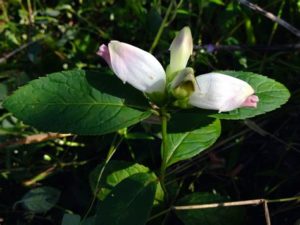
|
White TurtleheadHeight: 1 m
White Turtlehead is a beautiful wildflower species that can grow up to 1 m in height and spreads about 0.5 m. The leaves are oppositely arranged, dark green coloured, short-stalked, lance-shaped, and have sharply toothed margins. The flowers are whitish pink coloured, shaped like a turtle's head, made of two lips creating a tube, appear in dense spikes at the tip of erect stems, and bloom between August and October. The flowers are beneficial to pollinator species, like bees and butterflies.
|
Compartment A
Naturalization Area
Notes pH: acidic, basic
pH: acidic, basic Depth: potted, bareroot, wildflowers
Depth: potted, bareroot, wildflowers-
 Moisture: normal, moist
Moisture: normal, moist -
 Soil Type: loamy, clay
Soil Type: loamy, clay  Plant Height: max 1.5m, max 2m, max 3m
Plant Height: max 1.5m, max 2m, max 3m-
 Light conditions: full sun, partial sun
Light conditions: full sun, partial sun
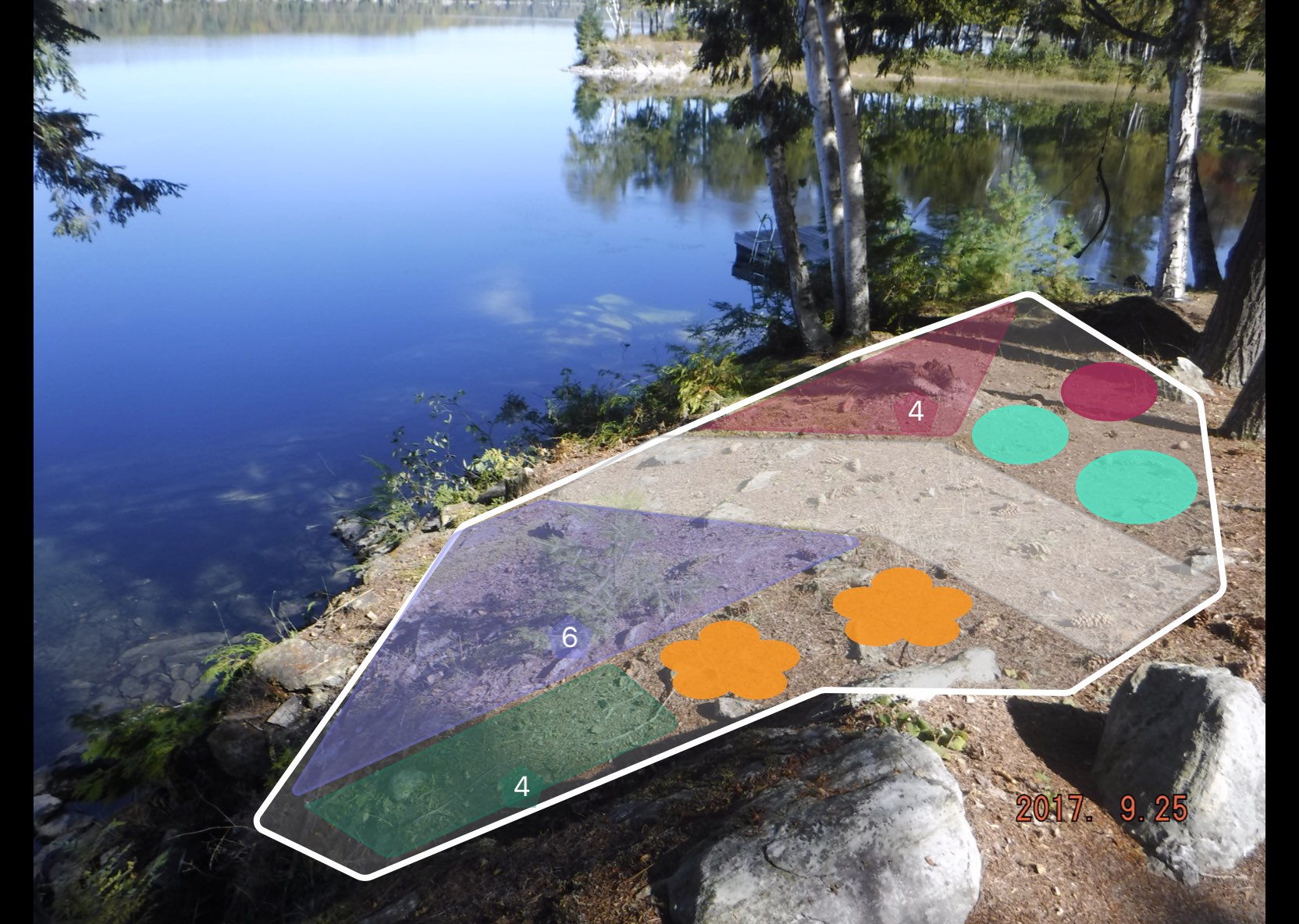
Compartment B
Naturalization Area
 pH: acidic
pH: acidic Depth: potted
Depth: potted-
 Moisture: dry
Moisture: dry -
 Soil Type: sandy, loamy
Soil Type: sandy, loamy  Plant Height: max 1.5m, max 2m
Plant Height: max 1.5m, max 2m-
 Light conditions: full sun, partial sun
Light conditions: full sun, partial sun
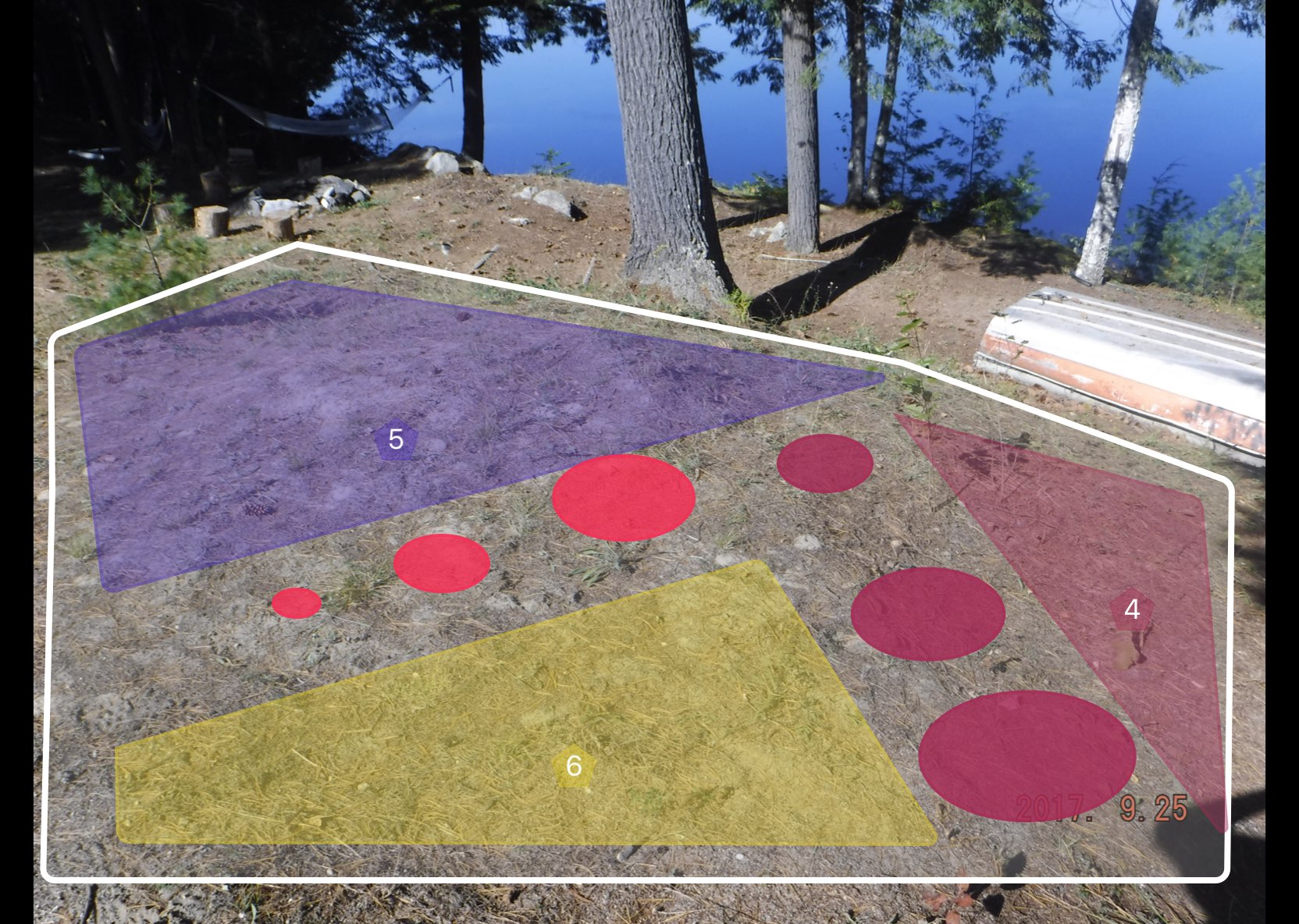
Schedule B
Financial Summary
Project by: Water Rangers
Shoreline Re-Naturalization Starter Kit includes: free site visit, customized re-naturalization planting plan for your shoreline property, native plants including free bare root (small) and potted (large) plants and wildflowers, coconut fibre pads to deter grass from growing around new plantings, tree guards for all deciduous trees, mulch for your wildflowers, Plant Care Guide with instructions on how to take care of your new plants, Habitat Creation Guide and a Wildflower Garden Guide.
Our planting plans are created onsite with you and provide detailed information and plans to re-naturalize your shoreline property. We take photos of areas for planting and overlay native plants that are well suited to your property based on site conditions such as soil type and sunlight availability.
We will work with you to create a plan that works for you including options for low growing plants in areas where views are important.
| Item | Quantity | Cost/Item | Subtotal |
|---|---|---|---|
| Starter Kit fee | $250 | ||
| Free potted plants | 6 | $0 | $0 |
| Free bareroot plants | 29 | $0 | $0 |
| Free wildflowers | 2 | $0 | $0 |
| Total costs | 250.00 |
Schedule C
Project Agreement
Stewardship Agreement
Please indicate your agreement to this proposed plan by signing the following Stewardship Agreement and submitting it, along with your financial contribution, to:
Water Rangers
290 Fifth Avenue
Ottawa, Ontario
Plant Availability
Please note that plant species may need to be changed based on plant stock availability at the time of ordering.
Project Completion
Upon receiving your signed stewardship agreement and financial contribution, a date will be booked for you to pick up your Natural Edge Kit. Water Rangers will supply all plants and materials. If you are paying for the planting to be completed for you, a date will be arranged for Water Rangers to plant your shoreline, bringing the plants and materials with them. If there are particular dates that you would prefer, we will do our best to accommodate your requests.
The Natural Edge Stewardship Agreement with Water Rangers
Agreement made this 2nd Day of the Month of February in the Year 2022.
BETWEEN Kathryn Neville 1 Gunns Farm Quebec (Hereinafter called the OWNERS)
AND Water Rangers 290 Fifth Avenue Ottawa, Ontario (Hereinafter called WC)
WHEREAS the Owners and WC have met and discussed plans for shoreline naturalization on the specified area(s) in Schedule A existing on the Owners’ land;
WHEREAS the Owners indicate approval of the project as proposed; and
WHEREAS the project is, or will be for the benefit of the Owners and others;
NOW THEREFORE THE PARTIES AGREE AS FOLLOWS:
1. This Agreement shall be in effect for a period of 5 years, commencing with the date of this Agreement.
2. The Owners and WC agree that the areas where the work is to be performed is as described in Schedule A.
3. The Owners agree to pick up their Natural Edge Starter Kit from WC’s office and plant their shoreline within two days of receipt. The Owners will provide “after” photos of the work completed to be used for reporting purposes. If the Owners wish to have the planting completed for them, then WC or it’s contractors, employees and agents will complete the planting at cost, as indicated in Schedule B.
4. If the planting is to be completed by WC, then the Owners grant WC, its contractors, employees and agents, the right to enter the property to perform the work agreed upon as outlined in Schedule A. In addition, WC, its contractors, employees and agents may inspect the work performed for the purposes of monitoring the project and survival assessment, with prior agreement with Owners for date and time of inspection.
5. The Owners agree to contribute the “Landowner contribution” and pay the costs indicated in Schedule B.
6. In instances where the Owners are to pay WC for work to be performed (outlined in Schedule A), the Owners agree to provide payments to WC prior to the commencement of that operation. Failure of payment shall constitute a breach of this Agreement and the Owners agree that this Agreement will be terminated and thereupon the Owners agree to pay WC the estimated costs of the operations of the project completed to date, if any.
7. The Owners agree, if necessary, to perform a reasonable amount of maintenance, which is described in the Native Plant Care Guide, available at naturaledge.watersheds.ca.
8. If a contractor is required to perform the work outlined in Schedule A, then the contractor carrying out the work on the land described will be required to take out and furnish evidence of a comprehensive policy of public liability and property damage coverage. The contractor and their workers will be required to be in good standing with the Workplace Safety and Insurance Board (WSIB) prior to performing the work.
9. The Owners agree not to remove, destroy or alter the project without prior consultation and approval of WC. Pruning and trimming planted nursery stock, or adding replacement native nursery stock is exempt.
10. The Owners agree not to mow the planted area.
11. The Owners do acknowledge that WC, its contractors, employees and agents, having performed said works, are not under further obligation with respect to survival of nursery stock, inspection, or maintenance.
12. The Owners, in the absence of negligence, hereby remise, release and forever discharge WC, its contractors, employees and agents from all claims and demands for injuries, including death, loss, damages and costs in any way related to or connected with installation and maintenance of the work described or resulting from any deleterious effects of the work to the land or to the lands and buildings thereon retained by the Owners.
IN WITNESS WHEREOF the parties have agreed to the contents of this plan; SIGNED:
About this program
About Water Rangers
Water Rangers are so cool. This is some interesting words.
This program was created by Watersheds Canada
We believe that every person has the right to access clean and healthy lakes and rivers in Canada. At Watersheds Canada, we work to keep these precious places naturally clean and healthy for people and wildlife to continue using for years to come. We love working with others to meet the needs of local communities, whether you’re a concerned citizen, a landowner, a lake association looking for help, or a coalition of groups interested in activating your local community.

